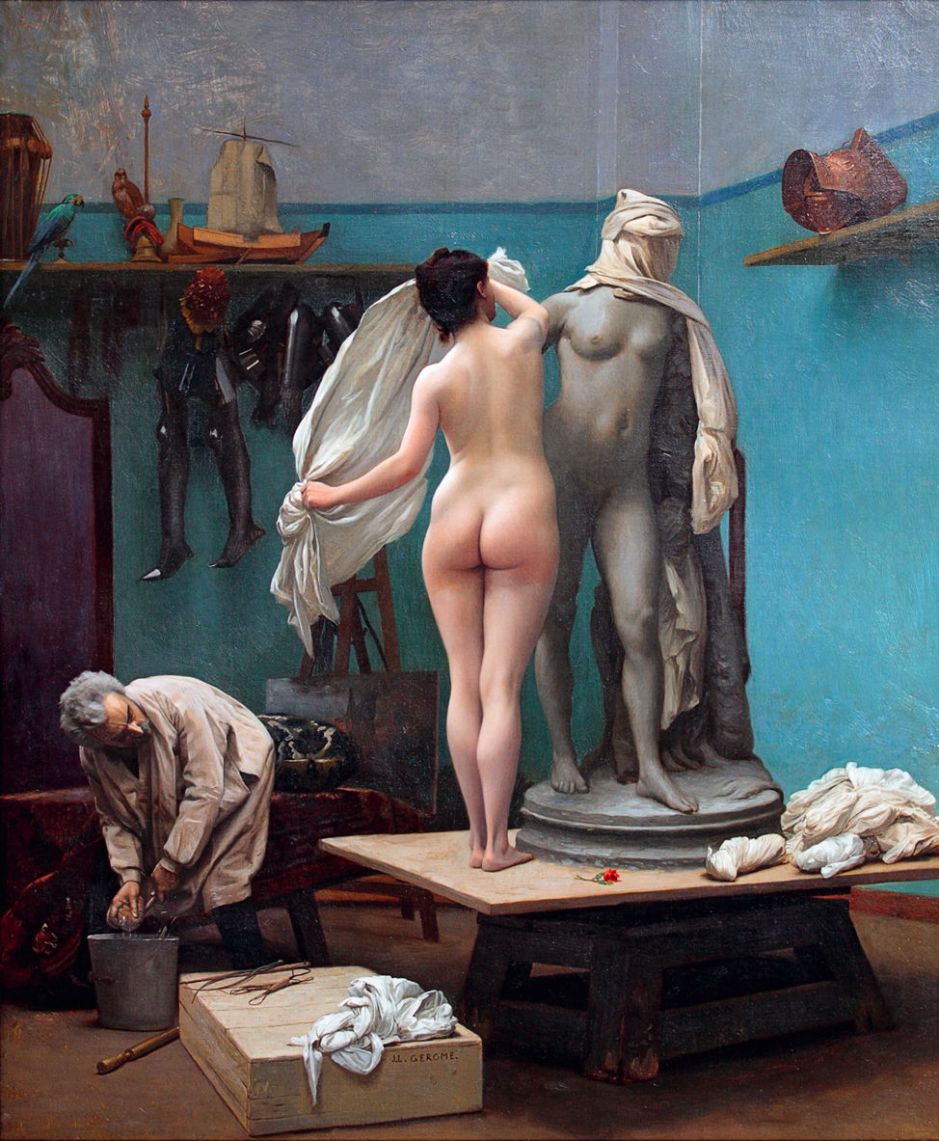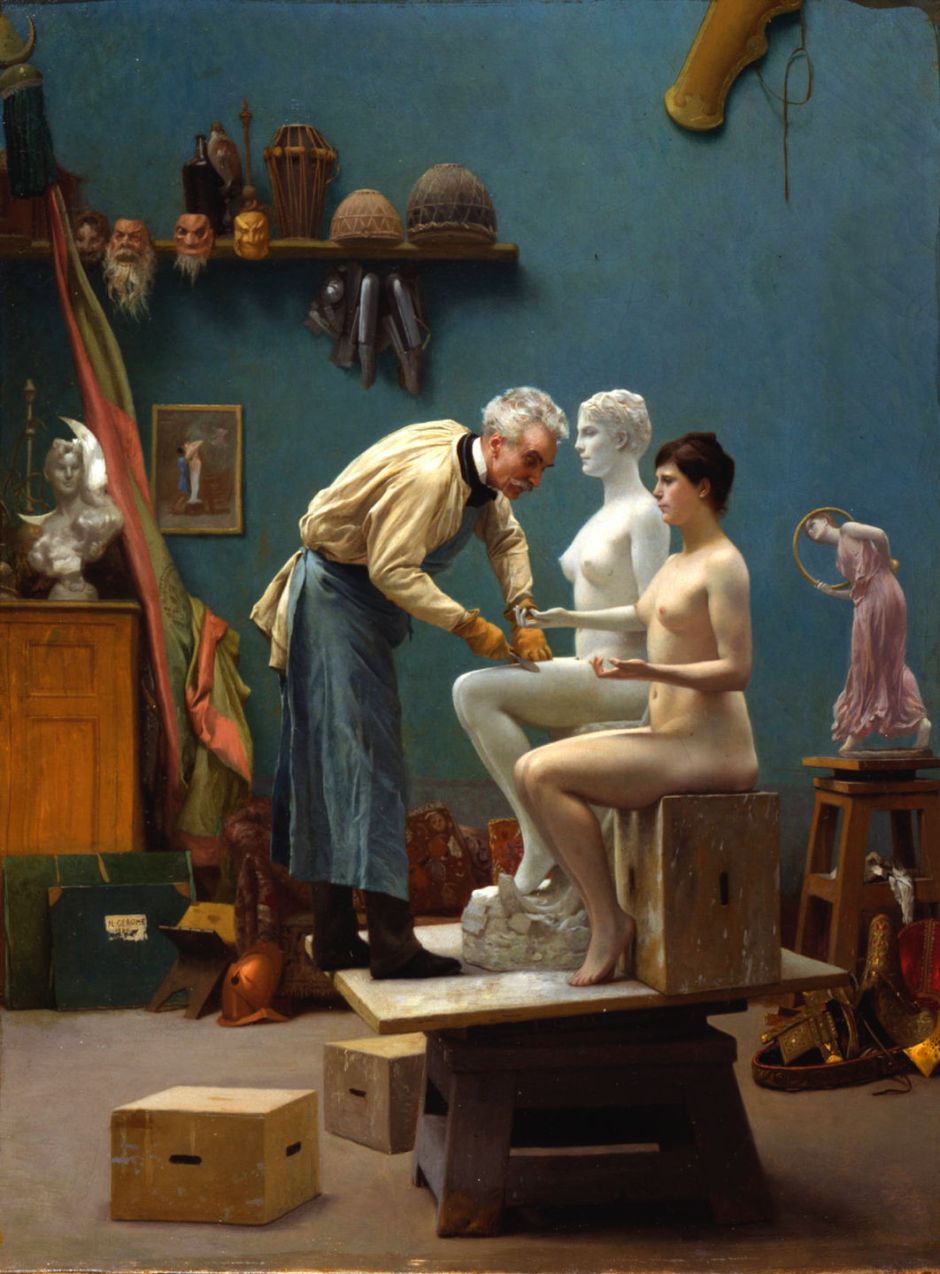In the first of these two articles looking at Jean-Léon Gérôme’s paintings about vision, visual fidelity, and the new art of photography, I showed paintings from early in his career, in 1849, to the startling shadow-play in his Golgotha from 1867.

Gérôme had started work on his most famous painting of all, Pollice Verso (1872), before 1869, but temporarily abandoned it during the Franco-Prussian War. It wasn’t, therefore, intended as comment on that war, nor about France’s sudden transition from Second Empire to Third Republic.
Instead, Gérôme looks at the power of expression – this time, a small gesture of the hand – in his favourite context, the Roman gladiatorial arena, which he had fallen in love with when he was first in Rome in 1843. It also develops a theme from his earlier Ave Caesar: that of spectators and their complicity in the horrific events taking place in front of them.
His earlier paintings of the arena had been troubled by difficulties in achieving historical accuracy in armour, weapons, and other details. Far from being a flight of fancy, Gérôme had spent a great deal of time and effort trying to make everything shown in this painting as historically accurate as possible at the time. For the artist, the success of the painting depended on its fine details.
To be able to bring out those fine details, and the thumb gesture which was central to its title and theme, Gérôme had to draw in from the wide-screen spectacle of Ave Caesar, and concentrate on the gladiators, and a small section of the spectators, including the emperor, his court, and those closest to him: a row of six Vestal Virgins, to the right.
The victorious gladiator stands with his right foot on the throat of the loser. He looks up at the crowd, to see whether he should kill that loser, indicated by thumbs pointing downward, or should spare his life, shown by thumbs pointing up. The title confirms what we can see: thumbs are down, and the gladiator on the ground is about to be brutally killed.

Critical commentary became focussed on the row of Vestal Virgins; in Gérôme’s earlier Ave Caesar, they had been sufficiently distant that their expressions and body language couldn’t be read. Here there was no doubt: they were baying for blood, which some critics found frankly revolting. However, it speaks clearly about the Romans’ enjoyment of such events, and a moment’s reflection should make us think more deeply about our own fascination in the suffering of other humans and animals.
Pollice Verso had the unintended consequence of making thumbs up and down signs part of the universal non-verbal vocabulary. The Romans did use hand signs involving the thumb to indicate their approval of gladiators killing their losers, but it’s now thought that these were more complex than those shown by Gérôme. This painting appears to have been responsible (at least in part) for defining the meaning of thumbs-up and thumbs-down gestures in popular communication.
During the 1880s, Gérôme increasingly turned to painting intriguing motifs involving himself as a sculptor, and sculpted figures.

His The End of the Pose (1886) is the first of a series of unusual compound paintings, which are at once self-portraits of Gérôme as a sculptor, studies in the relationship between a model and their sculpted double, and further forays into issues of what is seen, visual revelation, and truth. Here, while Gérôme cleans up, his model is seen covering up her sculpted double with sheets, as she remains completely naked. Apart from various diversionary entertainments, including a couple of stuffed birds and a model boat, there is a single red rose on the wooden platform on which the model and statue stand, a symbol of thanks from the artist to his model.
It isn’t far from here to the myth of the perfect sculptor, Pygmalion, whose creation was given life, turning statue into lover, which was Gérôme’s next step in 1890.

This study for Pygmalion and Galatea from 1890 was an early attempt at the composition, in which Pygmalion’s future bride is still a marble statue at her feet, but very much flesh and blood from the waist up. That visual device was perfect, but Gérôme recognised that his painting would be shunned because of its full-frontal nudity, so reversed the view.

His finished Pygmalion and Galatea (c 1890) extends the marble effect a little higher, and by showing Galatea’s buttocks and back and concealing the kiss, it stayed on the right side of what in the day was deemed decent. His attention to detail is, as always, delightful, with two masks against the wall at the right, Cupid ready with his bow and arrow, an Aegis bearing the head of Medusa, and a couple of statues about looking and seeing.

In 1874, archaeologists discovered large numbers of polychromed cast terracotta figurines in the Boeotian town of Tanagra. These dated from Greek civilisations active there during the late fourth century BCE, and their quantity and quality impressed many, including Gérôme. He moved on from Pygmalion to two works in which he built imaginary worlds around the Tanagra figurines. Sculpturae Vitam Insufflat Pictura (Painting Breathes Life into Sculpture) (1893) combines his own love of polychrome sculpture with a celebration of those archaeological discoveries.
In doing so, Gérôme progresses his theme of visual revelation and truth, with these painted miniature humans, mimicking reality, and the wooden box of masks in the foreground. Several of the figurines refer to his own painting and sculpture.

In The Artist’s Model (1895), Gérôme paints himself at work on his marble figure Tanagra (1890), which he had already included among the figurines in Sculpturae Vitam Insufflat Pictura above. He thus painted himself making a sculpture which he had previously painted in a painting as a sculpture.
Scattered in the image are reminders of gladiatoral armour and other props used for his paintings, one of his paintings of Pygmalion and Galatea, together with one of his polychrome sculptures of a woman with a hoop, at the right edge. In this single image, Gérôme has captured much of his professional career.

At this time, Gérôme painted a series of works showing the personification of Truth. First, she was shown as a nude at the bottom of a well, either lying on the ground, or standing with a mirror in her hand. Sadly, those have been lost, or remain inaccessible. The surviving version is probably his last, a painting which was so dear to Gérôme that he kept it close by in his studio up to the moment of his death.
Truth Coming out of her Well to Shame Mankind (1896) is based on a quotation from Democritus, “Of a truth we know nothing, for truth is in a well” (or, more literally, ‘in an abyss’), but knowing that reference is of little help in understanding these paintings.
Gérôme had given one of the earlier paintings the title of Mendacibus et histrionibus occisa in puteo jacet alma Veritas, which translates as ‘The nurturer Truth lies in a well, having been killed by liars and actors’. In this last version, she has climbed out of the well, and instead of bearing the customary mirror, she brandishes a whip to scourge us.
It’s often suggested that this series of works relate to the Dreyfus affair in France, but as they predate Zola’s famous article J’accuse! of 1898, that’s unlikely. I agree with more recent proposals that this Truth is the culmination of his themes of what is seen, visual revelation, and truth, particularly to nature. It is, perhaps, his last word on Impressionism, and his final defence of his life-long painting style.
Gérôme used the same allusion in his preface to Émile Bayard’s posthumous collection of collotype plates of photographs of nudes, Le Nu esthétique. L’Homme, la Femme, L’Enfant. Album de documents artistiques inédits d’après Nature, published in 1902:
Photography is an art. It forces artists to discard their old routine and forget their old formulas. It has opened our eyes and forced us to see that which previously we have not seen; a great and inexpressible service for Art. It is thanks to photography that Truth has finally come out of her well. She will never go back.

The last narrative painting securely attributed to Gérôme is a little joke of his which proved to be his greatest influence on twentieth century art: his Optician’s Sign from 1902. This plays on the French word opticien, and chien, French for dog. He apparently entered this in a competition. Years later, it was seized upon by Surrealists, and proved an inspiration for several of them.
The artist who had fought so long for what he believed to be visual truth had finally come to inspire Surrealism.
References
Ackerman GM (2000) Jean-Léon Gérôme, Monographie révisée, Catalogue Raisonné Mis à Jour, (in French) ACR Édition. ISBN 978 2 867 70137 5.
Scott Allan and Mary Morton, eds. (2010) Reconsidering Gérôme, Getty. ISBN 978 1 6060 6038 4.
Gülru Çakmak (2017) Jean-Léon Gérôme and the Crisis of History Painting in the 1850s, Liverpool UP. ISBN 978 1 78694 067 4.
de Cars L et al. (2010) The Spectacular Art of Jean-Léon Gérôme (1824-1904), Skira. ISBN 978 8 85 720702 5.

